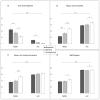Abnormal emotional and neural responses to romantic rejection and acceptance in depressed women
- PMID: 29547816
- PMCID: PMC5895529
- DOI: 10.1016/j.jad.2018.02.083
Abnormal emotional and neural responses to romantic rejection and acceptance in depressed women
Abstract
Introduction: Responding adaptively to one's social environment is a key factor predicting the course of major depressive disorder (MDD). Socially rejecting events can exacerbate, whereas socially accepting events can ameliorate depressive symptoms. The neural responses to rejection and acceptance in MDD are relatively unexplored.
Methods: We used functional magnetic resonance imaging (fMRI) to measure neural responses to romantic rejection and acceptance in women diagnosed with current MDD (n = 19) and a matched group of healthy controls (HCs) (n = 19). During fMRI, participants received rejecting, accepting, and neutral feedback from self-selected potential romantic partners.
Results: In women with MDD but not HCs, rejection significantly increased activity in the right anterior insula relative to neutral feedback. Greater activation during rejection was found in the dorsal anterior cingulate cortex in MDD compared to HCs. Women with MDD reported stronger emotional responses than HCs to both rejection and acceptance. In addition, left and right nucleus accumbens (NAcc) activity mediated the relationship between trait reward responsiveness and increased ratings of feeling "happy and accepted" following acceptance in HCs, but not the MDD group.
Discussion: Women with MDD were behaviorally and neurally hyperresponsive to rejection. Although both groups were behaviorally responsive to acceptance, in MDD this was dissociated from NAcc activity. These findings highlight abnormal behavioral and neural responses to social cues in MDD, with implications for disease prognosis and the development of novel and sensitive biomarkers for MDD focused on neural pathways for social-affective processing.
Limitations: Conclusions may be limited to depressed women in a romantic context.
Copyright © 2018 Elsevier B.V. All rights reserved.
Conflict of interest statement
Conflict of Interest
The authors report no financial interests nor potential conflicts of interest.
Figures




Similar articles
-
Sustained anterior cingulate cortex activation during reward processing predicts response to psychotherapy in major depressive disorder.J Affect Disord. 2016 Oct;203:204-212. doi: 10.1016/j.jad.2016.06.005. Epub 2016 Jun 4. J Affect Disord. 2016. PMID: 27295377 Free PMC article.
-
Differential neural correlates of autobiographical memory recall in bipolar and unipolar depression.Bipolar Disord. 2016 Nov;18(7):571-582. doi: 10.1111/bdi.12441. Epub 2016 Nov 4. Bipolar Disord. 2016. PMID: 27813234
-
It still hurts: altered endogenous opioid activity in the brain during social rejection and acceptance in major depressive disorder.Mol Psychiatry. 2015 Feb;20(2):193-200. doi: 10.1038/mp.2014.185. Epub 2015 Jan 20. Mol Psychiatry. 2015. PMID: 25600108 Free PMC article.
-
Subgenual anterior cingulate cortex and hippocampal volumes in depressed youth: The role of comorbidity and age.J Affect Disord. 2016 Jan 15;190:726-732. doi: 10.1016/j.jad.2015.10.064. Epub 2015 Nov 12. J Affect Disord. 2016. PMID: 26600415 Review.
-
Review of Abnormal Self-Knowledge in Major Depressive Disorder.Front Psychiatry. 2019 Mar 28;10:130. doi: 10.3389/fpsyt.2019.00130. eCollection 2019. Front Psychiatry. 2019. PMID: 30984035 Free PMC article. Review.
Cited by
-
Common neural responses to romantic rejection and acceptance in healthy adults.Soc Neurosci. 2020 Oct;15(5):571-583. doi: 10.1080/17470919.2020.1801502. Epub 2020 Sep 3. Soc Neurosci. 2020. PMID: 32715953 Free PMC article.
-
Dissociable Neural Responses to Monetary and Social Gain and Loss in Women With Major Depressive Disorder.Front Behav Neurosci. 2019 Jul 11;13:149. doi: 10.3389/fnbeh.2019.00149. eCollection 2019. Front Behav Neurosci. 2019. PMID: 31354443 Free PMC article.
-
Corticostriatal Responses to Social Reward are Linked to Trait Reward Sensitivity and Subclinical Substance Use in Young Adults.bioRxiv [Preprint]. 2024 Mar 16:2023.01.17.524305. doi: 10.1101/2023.01.17.524305. bioRxiv. 2024. Update in: Soc Cogn Affect Neurosci. 2024 Jun 17;19(1):nsae033. doi: 10.1093/scan/nsae033. PMID: 36711485 Free PMC article. Updated. Preprint.
-
Substance Abuse in Emerging Adults: The Role of Neuromelanin and Ventral Striatal Response to Social and Monetary Rewards.Brain Sci. 2022 Mar 4;12(3):352. doi: 10.3390/brainsci12030352. Brain Sci. 2022. PMID: 35326308 Free PMC article.
-
Altered frontal cortex functioning in emotion regulation and hopelessness in bipolar disorder.Bipolar Disord. 2021 Mar;23(2):152-164. doi: 10.1111/bdi.12954. Epub 2020 Jul 21. Bipolar Disord. 2021. PMID: 32521570 Free PMC article.
References
-
- Ayduk O, Downey G, Kim M. Rejection Sensitivity and Depressive Symptoms in Women. Pers Soc Psychol Bull. 2001;27:868–877.
-
- Boyce P, Hickie I, Parker G, Mitchell P, Wilhelm K, Brodaty H. Interpersonal sensitivity and the one-year outcome of a depressive episode. Aust N Z J Psychiatry. 1992;26:156–161. - PubMed
-
- Breines JG, Ayduk O. Rejection Sensitivity and Vulnerability to Self-Directed Hostile Cognitions Following Rejection. J Pers. 2015;83:1–13. - PubMed
MeSH terms
Grants and funding
LinkOut - more resources
Full Text Sources
Other Literature Sources
Medical

